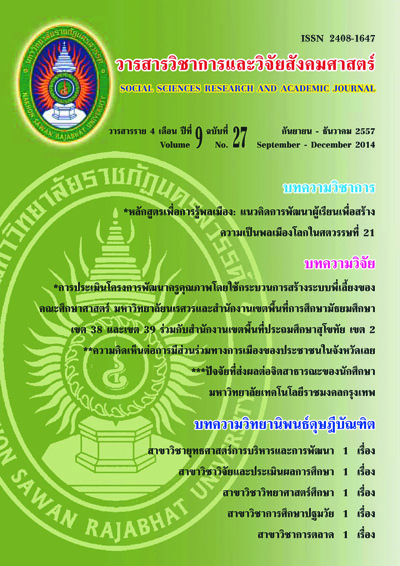การพัฒนารูปแบบการเรียนการสอนแบบ CLICK เพื่อส่งเสริมความสามารถ ในการตกผลึกทางปัญญา สำหรับนักศึกษาระดับปริญญาตรี สาขาการศึกษาปฐมวัย ; The Development of CLICK Model to Promote Crystallized Intellectual Abilities for Early Childhood Education Undergraduate S
Main Article Content
Abstract
บทคัดย่อ
การวิจัยครั้งนี้มีความมุ่งหมายเพื่อพัฒนารูปแบบการเรียนการสอนแบบ CLICK เพื่อส่งเสริมความสามารถ
ในการตกผลึกทางปัญญา สำหรับนักศึกษาระดับปริญญาตรี สาขาการศึกษาปฐมวัย การดำเนินการวิจัยแบ่งออกเป็น
4 ระยะ ได้แก่ ระยะที่ 1 ศึกษาสภาพข้อมูลพื้นฐาน ระยะที่ 2 สร้างรูปแบบการเรียนการสอนแบบ CLICK ระยะที่ 3
ทดสอบประสิทธิภาพรูปแบบการเรียนการสอนแบบ CLICK และระยะที่ 4 ประเมินประสิทธิภาพรูปแบบการเรียน
การสอนแบบ CLICK
ผลการวิจัย พบว่า
1. สภาพปัจจุบันของการจัดการเรียนการสอนในสาขาการศึกษาปฐมวัย นักศึกษาส่วนใหญ่มีพฤติกรรมการ
เรียนรู้แบบพึ่งพา ขาดทักษะกระบวนการคิดและขาดทักษะในการสร้างความรู้ด้วยตนเอง
2. รูปแบบการเรียนการสอนแบบ CLICK เพื่อส่งเสริมความสามารถในการตกผลึกทางปัญญาสำหรับ
นักศึกษาระดับปริญญาตรี สาขาการศึกษาปฐมวัย ประกอบด้วย 5 ขั้นตอน ได้แก่ ขั้นที่ 1 ขั้นวิเคราะห์ประเด็นเนื้อหา
ขั้นที่ 2 ขั้นนำมาสู่ปฏิบัติการเรียนรู้ ขั้นที่ 3 ขั้นร่วมมือบูรณาการ ขั้นที่ 4 ขั้นสร้างสรรค์ชิ้นงาน และขั้นที่ 5 ขั้นทำการ
แลกเปลี่ยนความรู้
3. ภายหลังการเรียนรู้ตามรูปแบบการเรียนการสอนแบบ CLICK เพื่อส่งเสริมความสามารถในการตกผลึก
ทางปัญญา สำหรับนักศึกษาระดับปริญญาตรี สาขาวิชาการศึกษาปฐมวัย นักศึกษามีความสามารถ ในการตกผลึก
ทางปัญญาสูงกว่าก่อนทดลองอย่างมีนัยสำคัญทางสถิติที่ระดับ .01 เมื่อพิจารณาเป็นรายองค์ประกอบ ได้แก่ การคิด
วิเคราะห์ การคิดสังเคราะห์ และการคิดประเมินค่า พบว่า หลังการทดลองมีคะแนนเฉลี่ยสูงกว่าก่อนการทดลองอย่าง
มีนัยสำคัญทางสถิติที่ระดับ .01 ทุกองค์ประกอบ
4. การศึกษาความคิดเห็นของอาจารย์ผู้สอน ที่ไม่ได้สังกัดโปรแกรมวิชาการศึกษาปฐมวัย ที่ปฏิบัติการสอน
นักศึกษาสาขาการศึกษาปฐมวัย ในภาคเรียนที่ 2 ปีการศึกษา 2556 ชั้นปีที่ 4 จำนวน 3 คน หลังการทดลองใช้รูปแบบ
การเรียนการสอนแบบ CLICK มีค่าเฉลี่ยของคะแนนความเหมาะสมตั้งแต่ 4.10-4.50 ถือว่ารูปแบบการเรียนการสอน
มีคุณภาพเหมาะสม
Abstract
The purposes of this research were to develop the CLICK model to promote crystallized intellectual
abilities for early childhood education program students. The research was divided into four phases, namely
Phase 1: studying the basic data of the samples group, Phrase 2: designing and creating a CLICK model, Phrase
3: trying - out the CLICK model and Phrase 4: evaluating the efficiency of the CLICK model.
The results of the research were concluded as follows:
1. The current situation of teaching in early childhood education found that most students have
behavior of learning dependencies and they lacked thinking process skills to educate themselves.
2. The CLICK model to promote crystalized intellectual abilities for early childhood education
students consisted of 5 stages, namely analyzing of contents, leading to learn, integrating partnership, creating
work and exchanging knowledge.
3. Crystallized intellectual abilities of students in early childhood education program after the
experiments were higher than before the experiment. It was found that the means after the experiment were
higher than those before the experiment with statistical significance at the level of .01. When specifically
considered each element including critical thinking, synthetic thinking, and cognitive evaluation, it was found
that the means after the experiment were higher than those before the experiment with statistical significance at
the level of .01.
4. The study and analysis of the three instructors’ opinions who do not belong to the early childhood
education program in semester 2/2013 found that after using the CLICK model showed an average rating of
4.10 to 4.50 and it was considered as a suitable quality teaching model.


